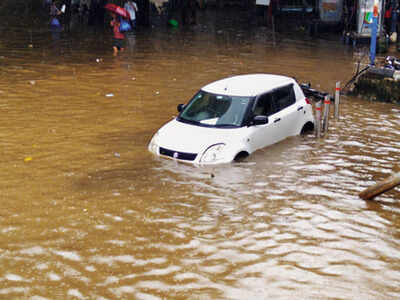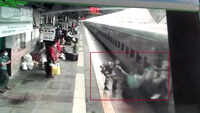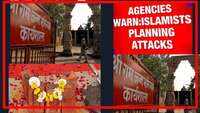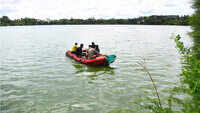
MUMBAI: Breaking its “all-time” record for the month of July, the Santacruz observatory reported 1,474mm rainfall till Tuesday evening.
The observatory was set up in 1944 and the highest rainfall recorded for July was 1,468.5mm in 2014. At 1464.8 mm, last year’s total rainfall for the month had fallen a little short of the 2014 figure. Though Mumbai had received a record 944.2mm rain over 24 hours on July 26, 2005, which left more than 1,000 people dead, the total rain for the month that year was 1454.5mm.
This year, in the first fortnight itself, Mumbai reported 840.7mm—its normal average rainfall for entire July—thanks to active monsoon conditions. For instance, 200.8mm of rainfall was recorded in the 24 hours between July 4 and 5.
Expect rainfall to intensify further from August 1: IMD
With the month not yet over, though, it is likely that the total rainfall for July could increase further in the coming days. The IMD has already issued a yellow alert for the city and its adjoining areas such as Thane, Palghar and Raigad for Wednesday, and forecast that heavy showers are “very likely” at isolated places.
“The satellite and radar images indicate cloudy weather over Maharashtra’s coast. This cloudiness has ensured that rains continue in Mumbai and its adjoining areas. The westerly to southwesterly winds were seen pushing in moisture. We expect rains to further intensify from August 1, considering a low pressure is developing over the Bay of Bengal. That may give the entire west coast significant rainfall,” said K S Hosalikar, deputy director-general (western region), IMD.
Meanwhile, in the early hours of Tuesday, significant rainfall was reported across the city and the suburbs. In the 12 hours ended 8.30pm on Tuesday, the IMD’s Colaba observatory reported 87.6mm rain, which fell in the heavy category according to the weather bureau's classification. By contrast, the Santacruz observatory recorded just 7.8mm, which falls in the light rain category. Following heavy rain in the island city, several low-lying areas got flooded. These included Hindmata in Dadar and parts of Wadala, which, in turn, hit traffic movement.
The observatory was set up in 1944 and the highest rainfall recorded for July was 1,468.5mm in 2014. At 1464.8 mm, last year’s total rainfall for the month had fallen a little short of the 2014 figure. Though Mumbai had received a record 944.2mm rain over 24 hours on July 26, 2005, which left more than 1,000 people dead, the total rain for the month that year was 1454.5mm.
This year, in the first fortnight itself, Mumbai reported 840.7mm—its normal average rainfall for entire July—thanks to active monsoon conditions. For instance, 200.8mm of rainfall was recorded in the 24 hours between July 4 and 5.
Expect rainfall to intensify further from August 1: IMD
With the month not yet over, though, it is likely that the total rainfall for July could increase further in the coming days. The IMD has already issued a yellow alert for the city and its adjoining areas such as Thane, Palghar and Raigad for Wednesday, and forecast that heavy showers are “very likely” at isolated places.
“The satellite and radar images indicate cloudy weather over Maharashtra’s coast. This cloudiness has ensured that rains continue in Mumbai and its adjoining areas. The westerly to southwesterly winds were seen pushing in moisture. We expect rains to further intensify from August 1, considering a low pressure is developing over the Bay of Bengal. That may give the entire west coast significant rainfall,” said K S Hosalikar, deputy director-general (western region), IMD.
Meanwhile, in the early hours of Tuesday, significant rainfall was reported across the city and the suburbs. In the 12 hours ended 8.30pm on Tuesday, the IMD’s Colaba observatory reported 87.6mm rain, which fell in the heavy category according to the weather bureau's classification. By contrast, the Santacruz observatory recorded just 7.8mm, which falls in the light rain category. Following heavy rain in the island city, several low-lying areas got flooded. These included Hindmata in Dadar and parts of Wadala, which, in turn, hit traffic movement.

Coronavirus outbreak
Trending Topics
LATEST VIDEOS
City
 RPF personnel saves man who fell from a moving train
RPF personnel saves man who fell from a moving train  Intelligence agencies flag 'possible' Islamist terror strikes in Ayodhya on the day of Ram Mandir Bhumi Pujan
Intelligence agencies flag 'possible' Islamist terror strikes in Ayodhya on the day of Ram Mandir Bhumi Pujan  AIMIM chief Asaduddin Owaisi slams PM Narendra Modi's plans to attend Ram Temple bhumi pujan
AIMIM chief Asaduddin Owaisi slams PM Narendra Modi's plans to attend Ram Temple bhumi pujan  Armed men barge inside house in UP's Ghaziabad, misbehave with female members, take away valuables
Armed men barge inside house in UP's Ghaziabad, misbehave with female members, take away valuables
More from TOI
Navbharat Times
Featured Today in Travel
Get the app




